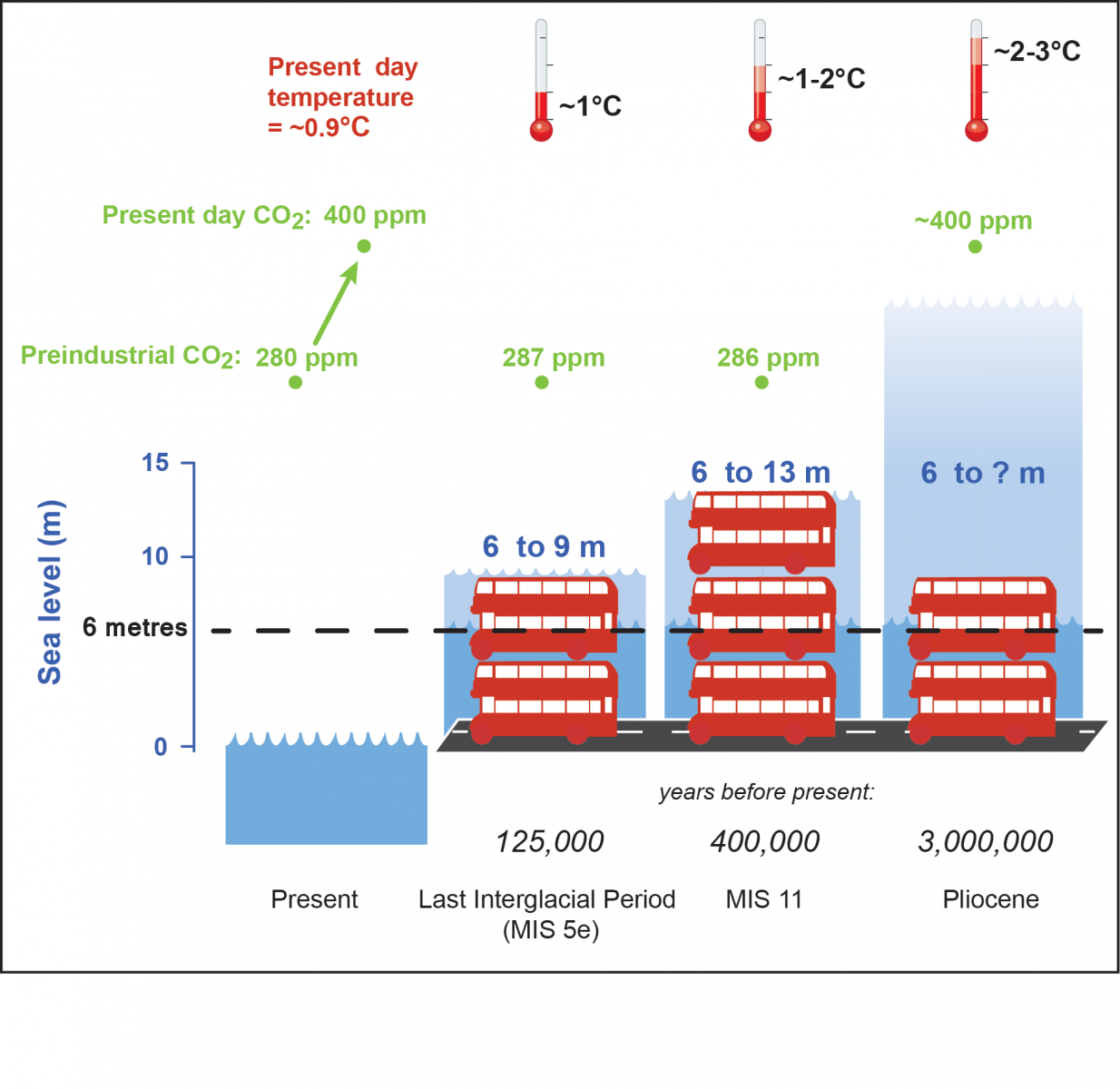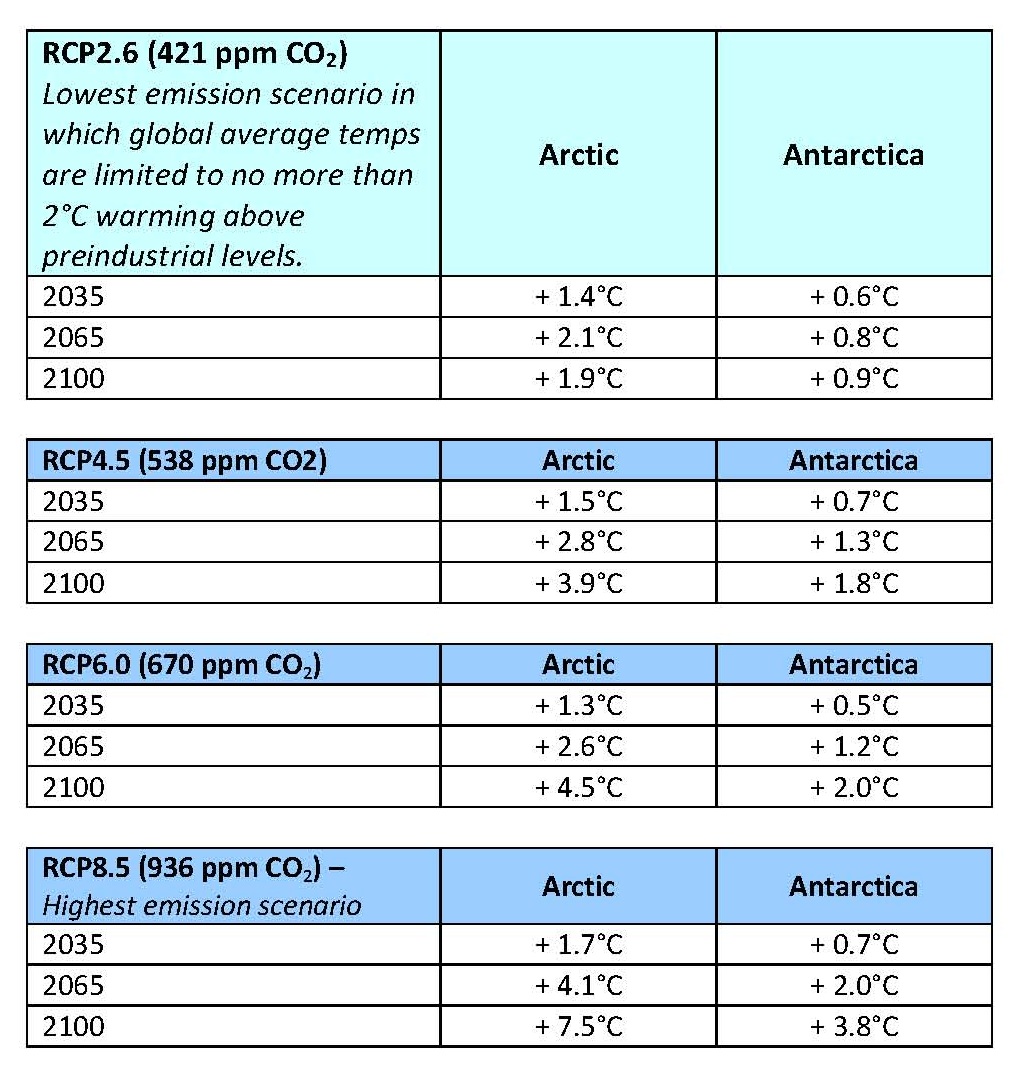Present temperature targets may commit Earth to at least 6 metres sea-level rise
The researchers, part of the international Past Global Changes project, analysed sea levels during several warm periods in Earth’s recent history when global average temperatures were similar to or slightly warmer than today – about 1°C above preindustrial temperatures. Nations have agreed to try to limit global average temperature to no more than 2°C above preindustrial levels, while warming is on course to reach four degrees by the end of this century if emissions continue on the current trajectory (Intergovernmental Panel on Climate Change Fifth Assessment Report 2013).
 Figure 1: Small increases in global average temperature may eventually lead to sea-level rise of 6 metres or more according to evidence from past warm periods in Earth’s history. Temperatures shown are relative to preindustrial levels. Present day temperature is around 0.9°C higher than preindustrial levels.
Figure 1: Small increases in global average temperature may eventually lead to sea-level rise of 6 metres or more according to evidence from past warm periods in Earth’s history. Temperatures shown are relative to preindustrial levels. Present day temperature is around 0.9°C higher than preindustrial levels.
The interdisciplinary team concluded that during the last interglacial – a warm period between ice ages 125,000 years ago – the global average temperature was similar to the present and this was linked to a sea-level rise of 6-9 metres, caused by melting ice in Greenland and Antarctica. Around 400,000 years ago when global average temperatures were estimated to be between 1 to 2°C higher than preindustrial levels, sea level reached 6-13 metres.
Lead author, Assistant Professor Andrea Dutton, University of Florida, said,
“During recent interglacial periods, global average temperatures similar to today, but slightly higher polar temperatures, resulted in more than 6 metres of global average sea-level rise”.
“The poles are on course to experience similar temperatures in the coming decades,” she added.
Noticeably, during these two periods, carbon dioxide in the atmosphere remained around 280 parts per million (ppm). The scientists also looked at sea level during the Pliocene, three million years ago, when carbon dioxide levels reached around 400 ppm – similar to today’s levels. They hypothesized that sea level was at least 6 metres higher than today and potentially substantially higher. Calculating precisely how high is complicated by the fact that geological forces push and pull Earth’s surface. Over three million years, this can cause vertical movement measuring tens of metres. Separating out the geological change in shoreline position from sea-level rise due to polar ice sheet disintegration is a challenge so in this instance the researchers were unable to identify a conclusive maximum limit.While the global average temperature rises of 1 to 3°C seem small, they were, like today, linked with magnified temperature increases in the polar regions which sustained over many thousands of years (See Table 1a).
Table 1a: Average polar temperatures during studied interglacials compared with the preindustrial average (estimates uncertain).
The Arctic is currently warming faster than the global average. Table 1b shows projected average polar land temperature changes (median) estimated over the coming century by the Intergovernmental Panel on Climate Change in its Fifth Assessment Report 2013. While, world leaders have agreed to keep global average temperature below 2°C, even this level sustained over a long period of time carries substantial risk of unmanageable sea-level rise, not least because carbon dioxide remains in the atmosphere for over a thousand years.
A key question for societies is, how fast did sea levels rise? The researchers say it is not presently possible to accurately ascertain the rate of sea-level rise during these previous warm periods and that more research is needed in this direction.
The researchers, members of PALSEA2 (PALeo constraints on SEA level rise 2), a group that investigates past sea-level rise and is hosted by the Past Global Changes (PAGES) project, used computer models and evidence from around the globe to arrive at their conclusions.
“This study confirms that our present climate is warming to a level associated with significant polar ice-sheet loss in the past. Studies such as these that improve our understanding of magnitudes of global sea-level rise due to polar ice-sheet loss, are critical for society, perhaps the most societally relevant information the paleo record can provide,” says co-author Associate Professor Anders Carlson of Oregon State University and leader of the PALSEA2 Working Group.

Table 1b: Projected average polar land temperature changes (median) estimated by the Intergovernmental Panel on Climate Change in its Fifth Assessment Report 2013 compared with 1986-2005 (Chapter 14 and Chapter 14 Supplementary Material).
PAGES was established in 1991 to facilitate international research into understanding past changes in the Earth system to improve projections of future climate and environment, and inform strategies for sustainability. It receives funding mainly from the Swiss and US national science foundations. PAGES is sponsored by Future Earth and the International Geosphere-Biosphere Programme.
PALSEA2 was formed in 2012 and brings together observational scientists and ice-sheet, climate, and sea-level modelers from around the globe to investigate how ice sheets, sea level, and climate change are related to each other and to provide a firm basis for projecting ice-sheet behavior in the future. Its predecessor, PALSEA, ran from 2008 to 2012 and investigated the relationship between sea-level rise and increases in temperature in the past.
Reference
“Sea-level rise due to polar ice-sheet mass loss during past warm periods”, Dutton et al., Science, to be published online 10 July 2015, DOI: 10.1126/science.aaa4019
Corresponding author: Assistant Prof. Andrea Dutton
+1 352-392-3626; adutton@ufl.edu
Reporter requests for paper and Science press enquiries:
AAAS Office of Public Programs
+1-202-326-6440; scipak@aaas.org
PALSEA2 working group website: http://people.oregonstate.edu/~carlsand/PALSEA2/Home.html
Past Global Changes (PAGES) project website:
http://www.pages-igbp.org/
DATE
July 9, 2015AUTHOR
Future Earth Staff MemberSHARE WITH YOUR NETWORK
RELATED POSTS
Program Now Available for the Year’s Top Sustainability Science and Innovation Event in Finland
Future Earth Members Join UN Ocean Conference in Barcelona
Apply for the 2024 Pathways Autumn School: Transformative Research for a Just World and a Habitable Planet